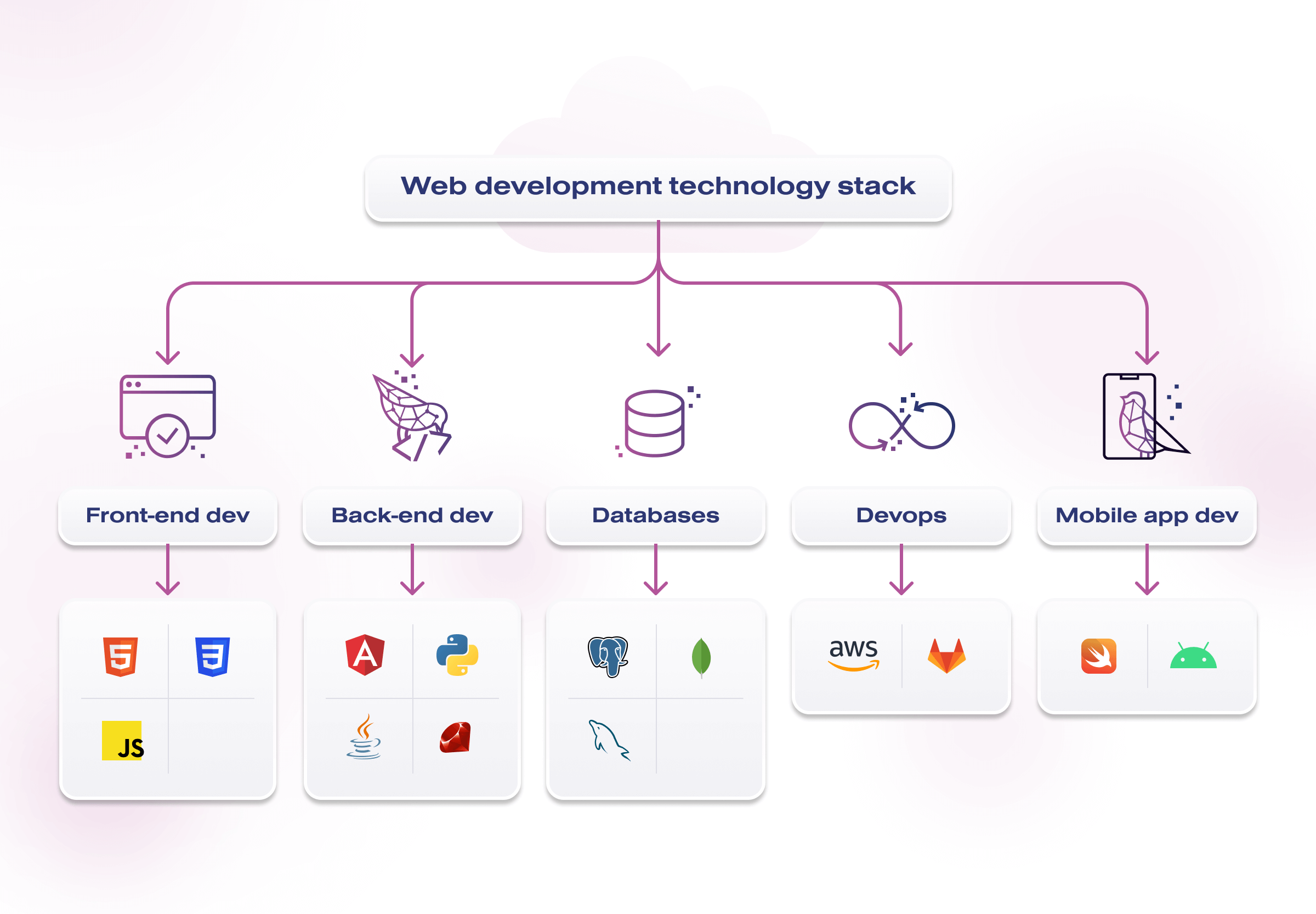The number of people who buy online is growing daily and is expected to reach 4.5 billion by 2024. E-commerce advancements may first seem to have made assembling a technology stack simpler than before. However, not all E-commerce architectural and technical components will work together. If you decide to utilize a certain programming language, will it work with the database you want to use?
Many eCommerce firms understand the importance of data – they prioritize collecting and keeping it and may even utilize some of it – but are unable to be strategic in their use of it to develop their business. 60-73% of data remain inactive, trapped in systems that don’t display to one other.
So, with many distinct options, the key to success isn’t picking a single tool: it is about ensuring you have a robust structure to expand successfully and scale.
To establish an e-commerce ecosystem that will perform effectively today and in the future, you need the correct e-commerce tools and tech stack. In this post, we’ll define an eCommerce technology stack, explore why it’s important, and go over the top eCommerce options.
Key points
What is an e-commerce technology stack?
An e-commerce technology stack is a group of frameworks, tools, programs, platforms, and programming languages required to build a website, a mobile app, or to operate and manage an eCommerce company. These platforms and tools are piled together to build a functioning system.
As the eCommerce sector becomes more competitive, the correct tech stack may help e-commerce organizations increase logistics efficiency, automate time-consuming operations, and save money. It also allows eCommerce — direct-to-consumer and B2B e-commerce — to develop a lean supply chain.
From the consumer’s perspective, companies may improve the customer experience by utilizing automation and other solutions such as automated order tracking, fast and effective returns handling, and delivery process.
Ecommerce technology is divided into segments:
- Front-end – client-facing
- Back-end – server-facing
- Third-party services
We cover each component below. Keep reading!
Ecommerce web development tech stacks overview
Let’s look at how web development works to grasp better how a technological tech stack works.

Ecommerce frontend technologies
The front-end contributes to the design of the E-commerce store’s user-facing part. As a result, front-end technical solutions are essential. The front end should be designed, so the user falls in love with your platform. Front-end development typically comprises the most well-known and cutting-edge website design and development technologies.
The loading speed of a website is a ranking element for search engines
An online store’s ideal loading time is 2.5 seconds. You may lose money if your online store does not load at least this fast.
Another crucial necessity for front-end development is responsive design. Mobile eCommerce sales accounted for more than half of all eCommerce sales. Your online business must be responsive to accept orders from mobile consumers. Various front-end technologies are utilized at the same time. Let’s go through them:
- HTML (HyperText Markup Language) is the standard language for creating documents that will be viewed in a web browser.
- CSS specifies the display of a page created in a markup language like HTML. The basic technology of the World Wide Web is CSS and JavaScript.
- JavaScript adds interactivity to static HTML websites. Front-end development JS libraries include React, Angular, Vue, and jQuery.
- Vue.js is a progressive open-source JS framework that aids in the development of online user interfaces and single-page apps. It is also suitable for creating lightweight eCommerce websites.
- Node.js enables the development of JS-based front-end and back-end applications. Node.js programming provides several benefits for eCommerce systems.
Ecommerce backend technologies
The backend is the unnoticed server-side component that generates the project’s logic and is essential for the front end to function properly. The backend of an e-commerce website is responsible for data validation, processing operations, and granting access to specified types of website usage. The backend comprises data from the application, the server, and the database, and their interaction provides a stable and resilient basis for the front operations.
The backend is in charge of functioning. These server-side apps and languages help your eCommerce website and software solutions connect.
- Databases
They are a key aspect of the back-end ecosystem since they allow us to analyze and store multiple data pieces. The most popular and commonly used databases are: MySQL, MongoDB, Amazon, Firebase, DynamoDB database, Google, PostgreSQL
- Servers
Servers are software that receives user requests, evaluates them, and then provides the requested content to those users.
Apache and Nginx are two popular open-source and free web servers. Apache is nine years older and hence a more proven and tested technology. Nginx is a newer server that is gaining popularity among developers owing to its unique design, which allows users to process a limitless amount of requests concurrently, making it an ideal server for high-volume websites.
- Programming languages
Various programming languages utilize different syntaxes to instruct a computer to do whatever is wanted. These are the key programming languages as Ruby, Java, Python, C#, Scala, and PHP) used in a website technology stack, together with their corresponding frameworks.
C# is the most general-purpose programming language to create adaptable software solutions, including eCommerce apps.
- Storage
That is an approach for handling and managing data storage as discrete components known as objects. Such items are stored in a single location and are not included in files contained within other folders. Regardless, object storage merges the data parts of a file, appends all associated information to that file, and fixes a custom identification.
An example is Amazon Simple Storage Solution, an object storage solution offering industry-leading data availability, scalability, performance, and security.
Google Firebase Storage is a simple, powerful, cost-effective object storage solution designed for the Google scale.
Third-party services
Third-party services guarantee that the E-commerce website has extra services. Third-party services improve the initial solution’s performance by allowing the online shop to function more quickly. They are widely used to increase efficiency and lower the cost of creating and administering an online business.
- Analytics software
- CRM
- Ordering
- Gateways for payments
- Social media platforms
When it comes to the IT stack, third-party solutions are crucial. There are several options available on the market. So, let’s have a look at some cutting-edge web technology.
Business functions to build your eCommerce tech stack around
These solutions are designed to boost conversions and the general performance of your online store. Some may appear apparent, while others are there to offer a little additional oomph to your e-commerce business’s success. Here’s an outline of the main areas on which to base your tech stack around.
Analytics
Any firm that wants to develop and improve its income must use analytics.
Analytics allows for the knowledge of client demands, website performance and data analysis, and measurement of metrics such as cart abandonment, loading times, and conversion rate.
Integrating analytics improves visibility by capturing, collecting, and showing real-time insights and data throughout your supply chain. This data may then be used to provide actionable insights, such as product suggestions. This help you attract and engage more consumers, increasing revenue and improving your business.
Planning
An organization may require an inventory management system to track and manage inventory across numerous sales channels. Enterprise Resource Planning works and track stocks across several channels, including wholesale and retail or business-to-business distribution.
Multichannel platform
Multichannel is required for firms to keep up with the competition. You need a technology stack that can manage multichannel commerce effortlessly and correctly. It includes using multichannel inventory management to keep your stock levels up to and current in real-time.
CRM Software
As your client base expands, managing it becomes considerably more difficult. How can you get and comprehend data on hundreds or thousands of consumers daily?
Customer relationship management software assists marketing, sales, and service activities and can assist in managing customer-related operations. They are an excellent task management tool for your team since they can assign and track workflow, collect customer information like names and purchase histories, and allocate resources.
It’s where they’ll put goods in their cart, make product or service inquiries, or even complain about the checkout procedure. Collect all of this data and assist you in developing meaningful interactions with your clients, which improves their experience and increases your sales.
The CRM functions as a back-end to the platforms your customers or users engage with, making their life easier as long as the data is accurate and current.
Customer support
A fantastic customer service experience guarantees that you keep your most valuable clients and convert new ones.
Integrating a customer service and support solution allows you to manage all interactions and relationships with your customers, providing an exceptional and consistent experience across all touchpoints.
Inventory management
Ecommerce enterprises that use effective order management can maintain track of all orders as they come in from various sales channels.
Furthermore, a solid inventory management system is required to track real-time stock levels, orders, and shipping from a single dashboard to estimate demand and optimize the inventory replenishment process, such as automated reorder point setting.
Shipping
Shipping software automates your order fulfillment and eCommerce shipping procedures and tracks freight delivery. It helps firms coordinate and smooth departing shipments to clients.
By gathering carrier data, validating an order, and delivering it to the nearest warehouse or distribution center, the proper solution may automatically look for the optimum route. Logistical automation via direct interfaces and API solutions enables online retailers to manage their logistics operations from a centralized system, providing more visibility and accurate operational data.
Ecommerce platform
E-commerce software provides users with a complete, all-in-one solution. Based on the platform type, hosting, payment processing, marketing tools, security, design, and merchant tools. For a fantastic user experience for your customers, you may build a professional e-commerce website utilizing various platforms and CMS.
You must have an eCommerce platform to launch an online store. The website, sales, and marketing are managed using an eCommerce platform. Users may browse and buy items that are for sale using this.
Although there are several choices, they fall into two categories:
- Hosted – An all-in-one solution and software-as-a-service architecture.
- Self-hosted – You are responsible for data development, hosting, and storage.
If you have any questions related to modern ecommerce solutions or have an idea about a future project, get in touch with us.
Order and payment processing
While many eCommerce systems include payment processing choices, third-party solutions offer extra alternatives and payment functionality.
An order processing and/or payment processing system that is completely automated can interface with an online store (or even several sales channels) and automatically process and validate orders as they are placed online.
Payment processing software is concerned with the back end of things. Thus, it has a direct influence on the consumer experience. However, it is still critical to choose a dependable payment processing platform that meets the demands of your organization to avoid any potential hiccups in the payment process.
Allowing payment from several sources and using reputable providers may boost consumer loyalty and conversion rates, resulting in increased profitability and sales.
Reporting
It is vital for continuing planning, strategy, and execution to connect all of your data sources to the reporting function. Knowing where the greatest leads come from and where your ad spend has the most impact will help you optimize your plans and allocate your budget more effectively.
This is one area where you can significantly boost your processes – the better you target important consumers, the less friction you’ll suffer.
Management of feedback and reviews
Customer feedback influences marketing strategy and customer service, which influences future evaluations, creating a feedback loop. Through re-conversion and conversion optimization, they pave the path for increased sales.
Worldwide facts:
- Products with more (positive) ratings sell faster
- Customers that have a positive experience purchase more items.
Customers that have a favorable experience with a company also buy more things. It is critical to use review management solutions to arrange that input. This area has several possibilities, so selecting one entails considering the rest of your eCommerce stack and selecting the tool that matches.
Marketing and content management
Without a place to communicate about your items and ways to promote them, your e-commerce tech stack is incomplete. Finding the correct tools to help you with digital marketing is an important aspect of e-commerce success. There are several factors to consider here, including your social media strategy, any blog space you may already have, and the talents of your staff members.
Main factors in choosing an eCommerce solution
The size of the business, the number of products supplied, the sector, the anticipated volume of visitors, and many other aspects must be taken into account immediately. We believe certain business challenges should be addressed using modern web technologies.
Time to market
Choose a tech stack that enables rapid development if you merely need a brief app to test a concept. You may prioritize the quality, flexibility, scalability, and performance of your development timetable allows.
Scalability
The scalability of an eCommerce platform impacts a company’s growth. You will lose market share and perhaps income every minute if your platforms and frameworks cannot grow rapidly enough without additional investment in people, effort, and money.
Compatibility
Any new platforms or technologies you use for your e-commerce project must be compatible with the ones you already have unless you are beginning from scratch. Examine your E-commerce architecture and technologies first to see what new features you can implement and how simple an upgrade will be.
Type of project
The type and size of the project have a direct impact on the platform, affecting the technology, you are going to use.
- Small project.
Suppose the company has less than 500 products and a limited time frame. In that case, we offer the development of an online store on the existing platform or CMS especially when the customer requests a working prototype of the site within a limited time.
- Medium-sized projects.
In this case, we will use several technologies when customers want to create an online store with more than 500 products that will withstand a large amount of traffic and have personalized features.
- Big and complex projects.
Suppose you want to invest in developing a personalized marketplace, social network, or online shop-level corporation with lots of integration and personalized features. In that case, we will use a completely different list of technologies.
Budget
The price of custom development is influenced by the e-commerce website, the size of the development team, the cost of website hosting, domain names, SSL certificates, PCI compliance, third-party integrations, and development time.
Cost factors include UI/UX design, front-end, and back-end development, testing, the complexity of the web architecture, the amount of third-party connectors, the SEO optimization process, maintenance, and development time. For a pricing quote on your unique E-commerce project, contact us.
Tips for choosing an eCommerce tech stack
Here’s how to create a successful tech stack for your online store.
- Go headless
For headless eCommerce to work, your website’s front-end and back-end layers must be separated. By doing so, you can easily keep the technical solution and presentation layer apart so that developers may quickly make modifications.
- Less plugins
A website with too many plugins will likely load much more slowly, negatively affecting user experience.
- Use adaptable programming languages and frameworks
While there is a big choice you used to create your website, go with something more up-to-date and adaptable. Even developing the most complicated websites or applications will help you save time.
- Start with solving challenges.
Investing in supply chain technology may assist you in resolving some of the most significant eCommerce pain points, whether you’re having trouble offering excellent customer service or wanting to streamline your fulfillment process.
- Don’t rely on too much technology
Many eCommerce problems are resolved by technology, which also increases your operational effectiveness. Technology is designed to save expenses and maintain lean operations, so you should know how it can aid your organization.
Conclusion
Your initial decision will determine the future of your company. So, be cautious when selecting a tech stack for your eCommerce website development; go for the best and you will get the best. You can follow our advice and achieve success in the future.
Establishing a technological stack is now simpler than ever, thanks to developments in e-commerce. However, not all technologies will integrate well, so consider every element you want to use before assembling your stack.
Choosing the ideal IT stack for your organization means that you always keep control at a lot lower time, money, and talent investment than ever before. By taking care of everything today, IT teams can devote their attention to what matters: preparing for the company’s future.





